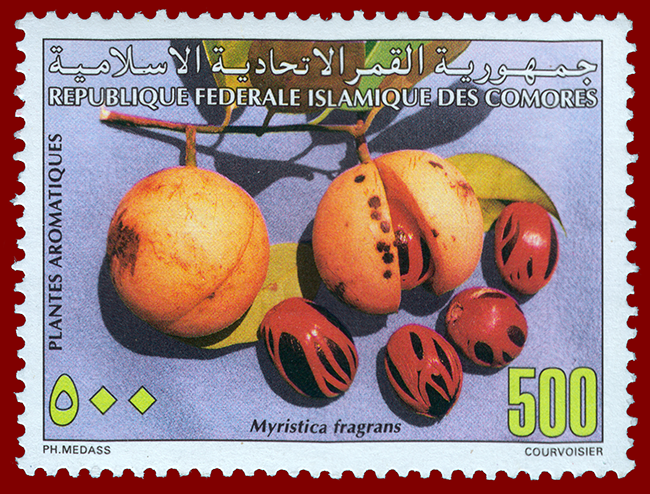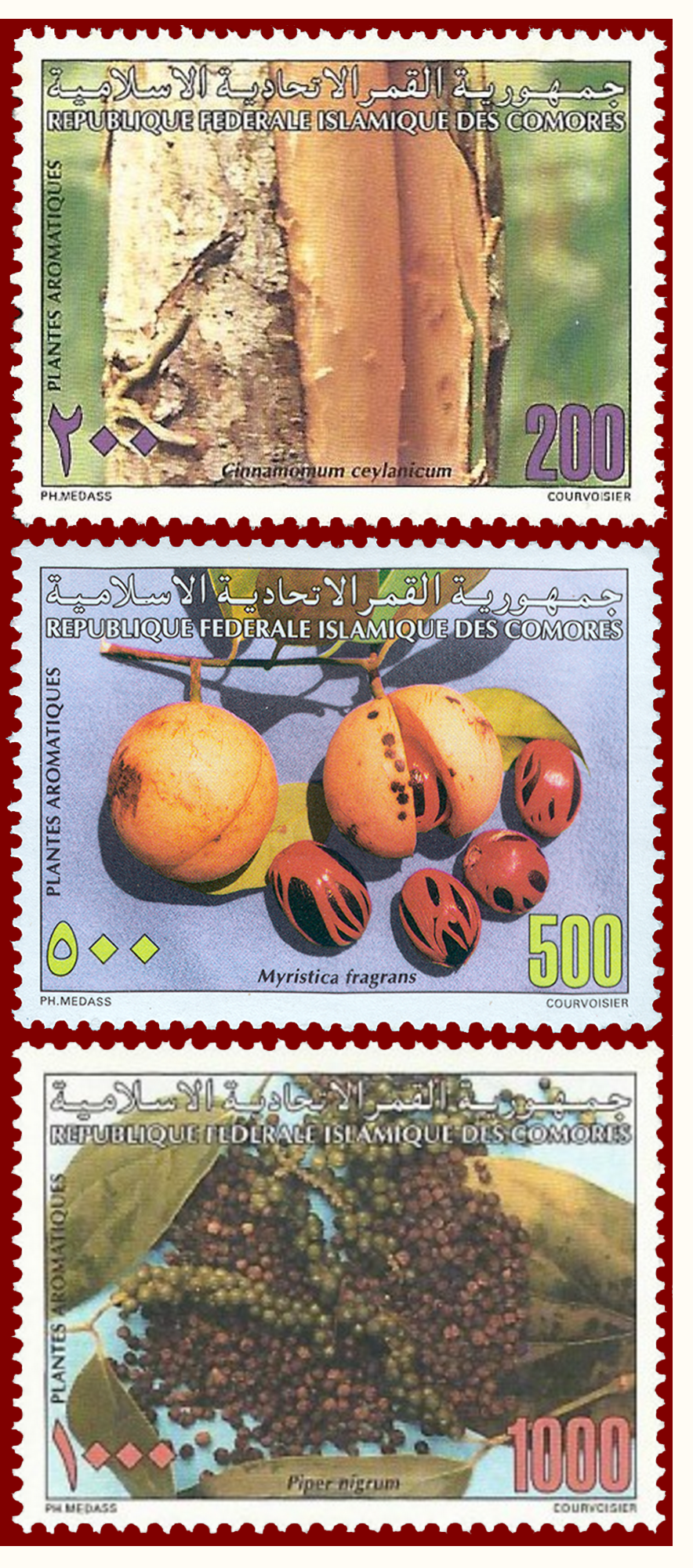NutmegGraters.Com

"Myristica Fragrans" "Plantes Aromatiques Series" Series

SERIES: COMORES ~ PLANTES AROMATIQUES
IMAGES & DENOMINATIONS:

Cinnamomum
Ceylanicum
200 Comorian francs
Myristica Fragrans
500 Comorian francs
Piper nigrum
1000 Comorian francs
DATE OF ISSUE: 1997.
STAMP SIZE: 27mm by 37mm.
PERFORATION: 21 by 28.
 PAPER: Unwatermaked.
PAPER: Unwatermaked.
PRINTING PROCESS: Photogravure.
SHEET CONTENT: unknown # stamps per sheet.
ADHESIVE:
Gum arabic (acacia gum).
PRINTER/DESIGNER: Hélio Courvoisier SA stamp printer in Switzerland.
HISTORY:
Within the lower right margin, on each stamp is printed"Courvoisier", an implication that the postal series is the product of Hélio Courvoisier SA stamp printer in Switzerland. Victor Manta, Switzerland writes for the Philatelic Webmasters Organization to expose the "exploit(ion) by dishonest stamp printers and/or dealers" who work for no fee in exchange for " having the right to print as many stamps as he thought he could sell to the philatelists." "The Philatelic Webmasters Organization actively collaborates with the Universal Postal Union in order to stop the issuing of illegal stamps", a problem that regularly plagues the poor and small countries in Africa. Often stated in associated with the sales promotion of this Comores ~ Plantes Aromatiques stamp series is the suspicious statements such as "VERY HART TO FIND ~ Not listed in Scott or Yvert" ~ such statements seem supportive of the stamps dubious authenticity. In spite of this, the Plantes Aromatiques series is very beautiful in design. Each stamp illustrate key indigenous Comorian agricultural products of cinnamon, nutmeg and pepper that have long been grown throughout the islands.
The Comoro Islands are located midway between northern Madagascar and the south-eastern coast of Africa. Until the 19th century, the Comoros Islands principally remained under Arabian influence. In 1841 (or 1843), the island of Mayotte became the possession of France, followed by the remaining three island falling under the "protective governance" of France in 1886. Although the inhabitants of Mayotte voted the continuation of French rule in 1961, the other three islands voted for autonomy and independence.
It is well documented that the first clove trees were planted in this region in 1770 and other imported crops of cinnamon, nutmeg and pepper were introduced into the Comoro's about 1830. In 1898, William Walter Augustine Fitzgerald traveled this region with support from the Royal Geographical Society and the Royal Colonial Society. Although Fitzgerald documented the presence of "nutmegs, capsicums, and the pepper vine (Piper nigrum)", he wrote that "as to the pepper vine and nutmeg {they are} not being cultivated" . . . {with} "cloves being the principal product" in this region. Although nutmeg trees have long been documented on the Comoro Islands, to date, there remains no evidence that the Comoro Islands have ever been significant growers of nutmeg. As recently as 2013, the agricultural advisory organization "Fairtrade Africa" encouraged the farmers on the Comoro's to "diversify their crops" becoming less dependent on their vanilla harvest. In response, 60 Fairtrade producers on the Comoro's set up new nurseries to grow ylang-ylang (used in perfume) and the spices of cloves and nutmeg.
[KLOPFER article © January 2018]